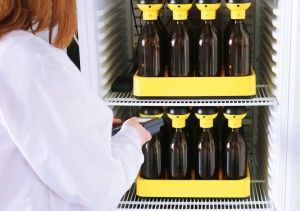In many areas of life, petroleum-based plastics are being replaced with biobased and biodegradable plastics. This also applies to microcapsules, which are used, for example, to encapsulate fragrances in detergents or cosmetics. Although the biobased plastics are produced from renewable raw materials and supposed to be biodegradable per se, they often have to be chemically modified in order to improve materials’ durability, for example. But to what extent are these modified biobased microcapsules still biodegradable? A team of researchers at the Fraunhofer Institute for Applied Polymer Research IAP is focusing on this question.

With the help of a test system, the oxygen demand during biodegradation in fresh water, seawater or soil can be determined for a wide variety of samples.
Natural substances are inherently biodegradable. They are undergoing a natural decomposition process in which organic matter is broken down by enzymes of microorganisms living in the soil. However, if natural substances are chemically modified, this can have a negative effect on their biodegradability.
Database on biodegradability of microcapsules
For more than 25 years, the Fraunhofer IAP has been developing microcapsules for a wide variety of applications – from encapsulated lubricants for moving plastic components such as gears or slide bearings, to fertilizers released in the soil over a long period of time and pigments that control the incidence of light in agricultural or greenhouse films. The sustainability of the wall material is also always in the focus of development. Cosmetic and hygienic products such as shower baths, shampoos or detergents also contain microcapsules made of modified natural substances such as gelatine. This biopolymer is often used as the wall material of microcapsules, which contain a fragrance and ensure that it is gradually released over a longer period of time. “So far, there is very little data available in the scientific literature on the biodegradability of microcapsules, or particles in the size range from about one micrometer to several millimeters. That is why we want to investigate various modified natural substances and establish a database with information on their biodegradability,” explains Kathrin Geßner, engineer in the Department of Microencapsulation and Polysaccharide Chemistry at the Fraunhofer IAP. “These data will not only be of interest for microcapsules, but also for a large number of other applications in which release of bioplastics into soil is possible. This will also enable us to expand our portfolio with regard to the development of microcapsules,” sais Geßner.
Testing the biodegradability in fresh water, seawater or soil
In order to be able to make a statement about biodegradability, the researchers carry out a manometric respiration test in accordance with OECD 301 F based on DIN EN ISO 14851. The researchers obtain the oxygen demand of the sample directly as a measured value. If the sum formula is known, the theoretical oxygen demand and finally the biochemical oxygen demand, or BOD , can be calculated. If a degradation value of 60 percent of the theoretical oxygen demand is achieved for the substance under investigation, it is considered to be biodegradable according to OECD 301 F.
“Among other things, we are developing microcapsule materials that biodegrade in an aqueous medium at 20 °C within 28 days. We get the microorganisms fresh from the sewage plant for each measurement,” says Geßner. The measurement system used was purchased with funds from the Federal Ministry of Food and Agriculture BMEL as part of the project “Improvement of the biodegradability of modified biobased polymers through the use of microencapsulated enzymes – enzymics” (funding code 22014118) of the Agency of Renewable Resources.
Another test method is available in the biopolymer processing pilot plant at theFraunhofer IAP’s Schwarzheide site, in which the oxygen consumed is not only measured but also can be replaced. In this way, aerobic degradation conditions can always be maintained even with high oxygen consumption. In addition, the formation of carbon dioxide, which is produced during sample degradation, can be measured too.
With the two measuring systems the samples can be examined in different test media. Thus, the biodegradability in fresh water, sea water or soil can be simulated and diverse information can be collected for the database.
Gelatine, gum arabic, cellulose acetate
In their series of investigations, the researchers determine the biodegradability of commercially available biopolymers before and after their modification. Chemical crosslinking of biopolymers is often used for the production of microcapsules.
“By the end of 2020, we want to examine all biopolymers routinely used in our company and their modifications. Initial investigations with gelatine and gum arabic suggest that many of the routinely used in microencapsulation processes modifications have only a minor effect on the biodegradability of polymers. The situation seems to be different with cellulose acetate: Depending on the type of modification, the biodegradability might even be completely lost,” explains Geßner.
Other biopolymers that the team of researchers will examine are alginate, carrageenan and polylactide. In addition to microcapsules and particles, the biodegradability of other materials and products developed at the Fraunhofer IAP is also being investigated, for example blends and compounds made from commercially available or in-house developed modified bioplastics such as PLA, PBS, PBSA, PBAT and starch- and cellulose-based plastics.
Source
Fraunhofer Institute for Applied Polymer Research IAP, press release, 2020-04-22.
Supplier
Fraunhofer-Institut für angewandte Polymerforschung (IAP)
Share
Renewable Carbon News – Daily Newsletter
Subscribe to our daily email newsletter – the world's leading newsletter on renewable materials and chemicals













